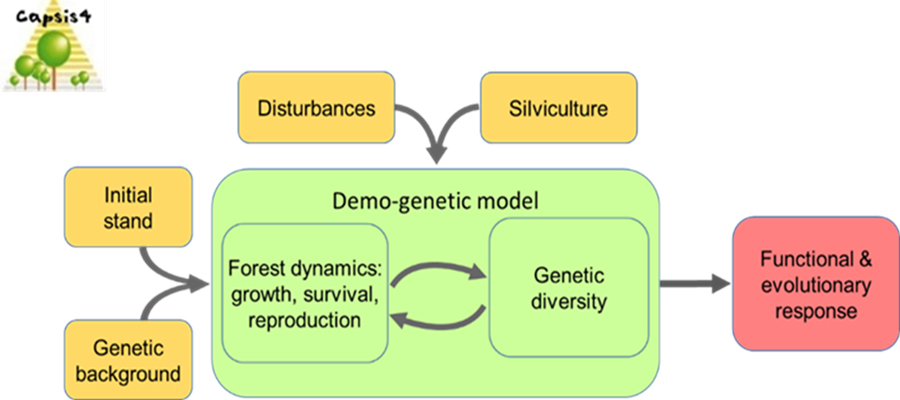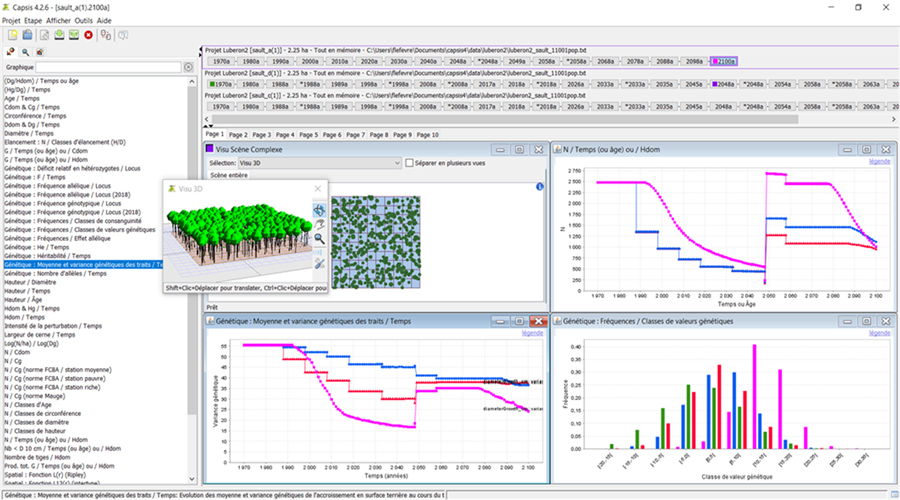LUBERON2

A forest demo-genetic model to simulate the joint effects of genetic diversity, disturbance regimes and management on stand dynamics, resilience, and evolution.

LUBERON2 is a forest growth model with natural regeneration, stochastic disturbance regimes and genetic variation of quantitative traits related to growth, reproduction and survival. It computes dendrometric, demographic, and genetic variables to compare different scenarios of genetic architecture, genetic diversity, environmental conditions, disturbance regimes, and management scenarios.
In OptFORESTS, we use LUBERON2 in research to explore and assess stand-level management strategies aiming to facilitate progressive genetic adaptation in the short-term (during stand development) and the long term (over tree generations) under various drought disturbance regimes, or aiming to rescue declining stands.
We also use LUBERON2 in training sessions for managers and decision-makers to raise awareness about the necessity of considering evolutionary processes in adaptive forestry strategies.
Main model information
LUBERON2 has a user-friendly graphical interface, in french or in english, and a script mode for intensive simulations. It can be used for:
- Research on eco-evolutionary processes in natural and managed forests
- Exploration and assessment of management options
- Teaching and training
Silver fir and related species, Atlas cedar, Douglas fir, Norway spruce, Larch
Yes
Yes, with two modalities: (1) external sources of pollen and seeds (grouped trees) near the target individualized-tree stand, (2) multiple individualized-tree stands in a single landscape (but memory limits)
Monospecific stands, even-aged by “parquet”
François Lefèvre, INRAE URFM (Avignon, France)
francois.lefevre.2@inrae.fr
Additional model description
- Distant independent tree growth model
- Growth response to drought stress level driven by local leaf area index
- Mortality by competition (self-thinning), or by disturbances
- Male and female fertility models
- Pollen and seed dispersal
- Mendelian inheritance of quantitative trait loci (QTL) and neutral genes
- Stand description (parcels, site indexes)
- Genetic architecture of adaptive traits and neutral genes
- Initial forest inventory with spatialized trees and individual genotypes
- Drought disturbance regime parameters (frequency and intensities)
- Management scenario
- Usual dendrometric variables describing stand composition and structure
- Quantitative genetic variables on vigor and sensitivity traits
- Genetic diversity variables on adaptive traits and neutral genes
List of references
- Godineau C., Fririon V., Beudez N., de Coligny F., Courbet F., Ligot G., Oddou-Muratorio S., Sanchez L., Lefèvre F. (2023 & updates). Luberon2 user manual: a forest demo-genetic simulation software on Capsis. https://capsis.cirad.fr/capsis/help_en/luberon2
- Godineau C., Fririon V., Beudez N., de Coligny F., Courbet F., Ligot G., Oddou-Muratorio S., Sanchez L., Lefèvre F. (2023). A demo-genetic model shows how silviculture reduces natural density-dependent selection in tree populations. Evolutionary Applications, 16:1830–1844. https://doi.org/10.1111/eva.13606
- Oddou-Muratorio S., Davi H., Lefèvre F. (2020). Integrating evolutionary, demographic and ecophysiological processes to predict the adaptive dynamics of forest tree populations under global change. Tree Genetics & Genomes, 16:67. https://doi.org/10.1007/s11295-020-01451-1
- Lefèvre F., Boivin T., Bontemps A., Courbet F., Davi H., Durand-Gillmann M., Fady B., Gauzere J., Gidoin C., Karam M.J., Lalagüe H., Oddou-Muratorio S., Pichot C. (2014). Considering evolutionary processes in adaptive forestry. Annals of Forest Science, 71:723-739. https://doi.org/10.1007/s13595-013-0272-1

